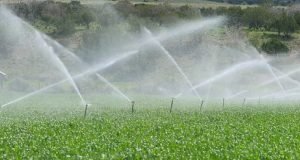Sprinkler Irrigation System – its 4 Types, Uses & Advantages
The sprinkler irrigation system is a method in which water is sprayed into the air and allowed to fall on the ground surface like rainfall and through small orifices or nozzles, the spray is expanded by the flow of water under pressure.
With the help of pumping, the pressure is usually obtained to refill the crop root zone that can be applied with careful selection of nozzle sizes, operating pressure, and sprinkler spacing for the amount of irrigation water required.

Usually, by pumping, water is distributed through a system of pipes and then sprayed into the air through sprinklers. So, it breaks up into small water drops that fall to the ground, and to enable a uniform application of water, the pump supply system, sprinklers, and operating conditions must be designed.
The sprinkler irrigation system is suited for most row, field, and tree crops and it is also adaptable to any farmable slope.
Types of Sprinkler Irrigation System:
There are four types of the sprinkler irrigation system as given below;
- Traditional Spray Systems
- Drip Systems
- Soaker Hoses
- Rotor Systems
Traditional Spray Systems:
Traditional spray system comprises of pop-up and ground-level heads that spray water in a half, full or quarter circle and for widespread water coverage, it is known.
To spray water in the surrounding area, this type of sprinkler irrigation system uses a pop-up head and they are not as efficient as other types. This system actually sprays too much water so the ground cannot absorb it fast enough which also leads to wasted water.

Be sure that each sprinkler head is installed at a distance that allows it to cover the area that the next closest head does not if you choose this system.
Drip Systems:
The drip system is one of the best options for environmentalists and it can be suitable for different plantings it uses a fraction of the water and supplies it slowly to the soil allowing it to absorb it at its own pace and this system is water-efficient.
In different types such as bubblers, drippers, soakers, and micro-sprayers the drip devices are available, and to meet the requirement of different plants, you can customize this system.

In windy conditions, this sprinkler irrigation system also works well and wind will not have an impact on its effectiveness because the water is distributed directly onto the soil instead of sprayed into the air.
Soaker Hoses:
Soaker hoses should be considered by homeowners before making a final decision and they are not technically sprinklers but are a type of irrigation system. Throughout landscaping, soaker hoses are laid and emit water throughout the entire length of the hose.

For homeowners who have dense landscaping that is difficult to water using one of the traditional sprinkler irrigation systems, soaker hoses are a wise choice for them.
Rotor Systems:
In your yard, rotors are capable of covering a wider area and are much more efficient. Rotors also release water at a slower rate and are therefore more energy efficient than the drip systems and on larger yards, this system used to be used solely.

You have complete control as your landscaping situation changes throughout the year because most rotor sprays allow you to adjust the nozzle to change how far the water sprays and how much water is released.
There are also many types of rotor systems available such as pop-up spray, impact, gear-driven, large turf, etc.
Uses of Sprinkler Irrigation System:
There are the following uses of this system such as;
Suitable for Crops:
For most row, field and tree crops sprinkler irrigation is suited and over or under the crop canopy, water can be sprayed. However, for irrigation of delicate crops like lettuce, large sprinklers are not recommended because crops may damage by the large water drops.
Suitable for Slopes:
To any farmable slope, whether uniform or undulating sprinkler irrigation is adaptable and along the land contour, the lateral pipes supplying water to the sprinklers should always be laid out whenever possible. This will provide uniform irrigation and minimizes the pressure changes at the sprinklers.
Suitable for Soils:
To sandy soils with high infiltration rates sprinklers are best suited and to most soils, they are adopted. Surface ponding and runoff can be avoided by the average application rate from the sprinklers which is always chosen to be less than the basic infiltration rate of the soil in mm/hour.
The soils which easily form crust sprinklers are not suitable but light fine sprays should be used if sprinkler irrigation is the only method available.
Suitable for Irrigation:
To avoid problems of sprinkler nozzle blockage and spoiling the crop by coating it with sediment a good clean supply of water and free of suspended sediments is required. So, the sprinkler irrigation system is suitable for irrigation.
Advantages of Sprinkler Irrigation System:
There are the following advantages as listed below;
- To all types of soil except heavy clay, it is suitable.
- For irrigating crops where the plant population per unit area is very high, this system is suitable.
- For oilseeds and other cereal and vegetable crops it is most suitable.
- It is easy to set up and affordable.
- Water measurement is easier in this system.
- Easy automation and mechanization.
Disadvantages:
There are also some disadvantages such as;
- It has a high operating cost and when there is a lot of wind, water will drift.
- There is a need for a stable water supply.
- Saline water may cause problems and water must be free from a large amount of salt, sand, and debris.
